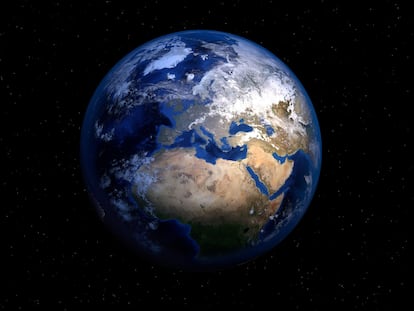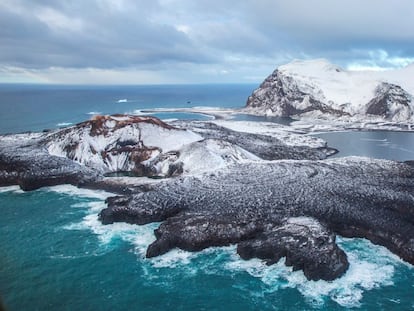The Earth’s core is slowing down
The study of more than 100 earthquakes confirms that the sphere, roughly the size of the Moon, is reversing relative to the planet’s surface

A study has just confirmed that the Earth’s inner core is backtracking — slowing down — in relation to the planet’s surface, according to new research published in the journal Nature.
Scientists have been debating the movement of the inner core for decades. Some research indicates that the innermost part of the planet rotates faster than the surface, while other studies argue the opposite. The new study provides “unambiguous evidence” that the inner core began slowing down around 2010 and is now slower than the Earth’s surface, according to its authors.
“When I first saw the seismograms that hinted at this change, I was stumped,” said John Vidale, a researcher at the University of Southern California and co-author of the work, in a press release. “But when we found two dozen more observations signaling the same pattern, the result was inescapable. The inner core had slowed down for the first time in many decades. Other scientists have recently argued for similar and different models, but our latest study provides the most convincing resolution.”
Last year, similar work by Chinese scientists raised alarms that the Earth’s inner core — a sphere of nearly pure iron more than 3,100 miles (5,000 kilometers) deep that is hotter than the Sun — had slowed down and was spinning in the opposite direction to the planet’s surface. While the effects of this phenomenon on daily life are imperceptible, it could change the length of days by a few fractions and even deform the Earth’s crust.
According to the study in Nature, the inner core is considered to be reversing and backtracking relative to the planet’s surface due to moving slightly slower instead of faster than the Earth’s mantle for the first time in approximately 40 years. Relative to its speed in previous decades, the inner core is slowing down.
Previous studies have revealed that this lack of synchronization follows something similar to cycles, and that a couple of decades ago, the inner core that rotated faster than the mantel. But beginning in the 2010s, the phase changed, and the Earth’s core began to rotate slower than the surface.
The inner core is a large ball of iron and nickel surrounded by the outer core, made of the same material, but in a liquid state. The inner core is about the same size as the Moon. Understanding the inner core is a huge challenge because it can’t be viewed or visited. Scientists use the seismic waves from earthquakes to create renderings of the inner core’s movement.
Vidale and his colleague Wei Wang from the Chinese Academy of Sciences analyzed the waves produced by 143 pairs of identical earthquakes that took place in the same place and produce identical seismograms.
In this study, the researchers compiled and analyzed 121 earthquakes recorded around the South Sandwich Islands that occurred between 1991 and 2023. They also looked at tremors caused by explosions from identical nuclear bombs detonated by the Soviet Union between 1971 and 1974, as well as repeated French and U.S. nuclear tests from other studies of the inner core. The work agrees that the core of the planet rotated faster than the surface between 2003 and 2008. From that year to the present, the inner core reduced its speed threefold and began moving in the opposite direction to the crust.
Vidale believes that the slowdown of the inner core is explained by friction with the outer core, which is made of liquid metal. This process is essential for life on Earth, as it produces a dynamo effect that generates the Earth’s magnetic field, which protects the planet from space radiation. The scientist adds that the slowing speed was also caused by the gravitational tugs from the dense regions of the overlying rocky mantle.
Researcher Xiadong Song, from the Institute of Theoretical and Applied Geophysics at Peking University who published the 2023 study on the inner core, explains that this new work confirms his results and “provides a clear demonstration that the backtracking is really happening.” He added: “Importantly, we are talking about the rotation of the inner core relative to the Earth’s surface; that is, the inner core was rotating slightly faster than the Earth’s rotation before 2009, was synchronized around 2009, and has been rotating slightly slower since 2009. The finding is an impressive demonstration that our planet is so dynamic that its deep motion can be vividly revealed to our human eyes.”
The implications of this change in the motion of the inner core for the Earth’s surface are a matter for speculation. Vidale points out that backtracking can alter the length of a day by fractions of a second. “It’s very hard to notice, on the order of a thousandth of a second, almost lost in the noise of the churning oceans and atmosphere,” he said. “The dance of the inner core might be even more lively than we know so far.”
Sign up for our weekly newsletter to get more English-language news coverage from EL PAÍS USA Edition
Tu suscripción se está usando en otro dispositivo
¿Quieres añadir otro usuario a tu suscripción?
Si continúas leyendo en este dispositivo, no se podrá leer en el otro.
FlechaTu suscripción se está usando en otro dispositivo y solo puedes acceder a EL PAÍS desde un dispositivo a la vez.
Si quieres compartir tu cuenta, cambia tu suscripción a la modalidad Premium, así podrás añadir otro usuario. Cada uno accederá con su propia cuenta de email, lo que os permitirá personalizar vuestra experiencia en EL PAÍS.
¿Tienes una suscripción de empresa? Accede aquí para contratar más cuentas.
En el caso de no saber quién está usando tu cuenta, te recomendamos cambiar tu contraseña aquí.
Si decides continuar compartiendo tu cuenta, este mensaje se mostrará en tu dispositivo y en el de la otra persona que está usando tu cuenta de forma indefinida, afectando a tu experiencia de lectura. Puedes consultar aquí los términos y condiciones de la suscripción digital.
More information
Archived In
Últimas noticias
A survivor’s account of the Interoceanic Train accident: ‘We were scared because of the speed on the curve’
The Interoceanic Train, the Mexican alternative to the Panama Canal
What is known about the Interoceanic Train derailment in Oaxaca
Trump turns a Minnesota fraud allegation into ammunition for his MAGA army against Democrats
Most viewed
- Oona Chaplin: ‘I told James Cameron that I was living in a treehouse and starting a permaculture project with a friend’
- Reinhard Genzel, Nobel laureate in physics: ‘One-minute videos will never give you the truth’
- Why the price of coffee has skyrocketed: from Brazilian plantations to specialty coffee houses
- Pablo Escobar’s hippos: A serious environmental problem, 40 years on
- Chevy Chase, the beloved comedian who was a monster off camera: ‘Not everyone hated him, just the people who’ve worked with him’











































